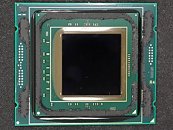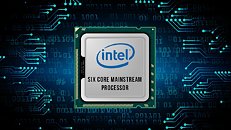Friday, September 22nd 2017

Intel Core i7 8700K Reportedly Reaches 4.8 GHz Easily, 5 GHz+ Requires Delid
A report out of Expreview says that users should expect Intel's 8700K 6-core processor to easily clock up to 4.8 GHz with conventional cooling methods. Apparently, the chip doesn't even need that much voltage to achieve this feat either; however, thermal constraints are quickly hit when pushing Intel's latest (upcoming) leader for the mainstream desktop parts. Expreview says that due to the much increased temperatures, users who want to eke out the most performance from their CPU purchase will likely have to try and resort to delidding of their 8700K. While that likely wouldn't have been necessary with Intel's 7700K processors, remember that here we have two extra CPU cores drawing power and producing waste heat, so it makes sense that thermals will be a bigger problem.
This is understandable: Intel is still using their much chagrined (and divisive) TIM as a heat conductor between the CPU die and the CPU's IHS (Integrated Heat Spreader), which has been proven to be a less than adequate way of conducting said heat. However, we all knew this would be the case; remember that Intel's HEDT HCC processors also feature this TIM, and in that case, we're talking of up to 18-core processors that can cost up to $1,999 - if Intel couldn't be bothered to spend the extra cents for actual solder as an interface material there, they certainly wouldn't do so here. As with almost all peeks at as of yet unreleased products, take this report (particularly when it comes to frequencies, as each CPU overclocks differently) with a grain of salt, please.
Source:
Expreview
This is understandable: Intel is still using their much chagrined (and divisive) TIM as a heat conductor between the CPU die and the CPU's IHS (Integrated Heat Spreader), which has been proven to be a less than adequate way of conducting said heat. However, we all knew this would be the case; remember that Intel's HEDT HCC processors also feature this TIM, and in that case, we're talking of up to 18-core processors that can cost up to $1,999 - if Intel couldn't be bothered to spend the extra cents for actual solder as an interface material there, they certainly wouldn't do so here. As with almost all peeks at as of yet unreleased products, take this report (particularly when it comes to frequencies, as each CPU overclocks differently) with a grain of salt, please.


119 Comments on Intel Core i7 8700K Reportedly Reaches 4.8 GHz Easily, 5 GHz+ Requires Delid
[INDENT]chagrin, n. -- A keen feeling of mental unease, as of annoyance or embarrassment, caused by failure, disappointment, or a disconcerting event.[/INDENT]
Instead of "chagrined", a more appropriate word might be: despised, detested, loathsome, deplorable, reviled, disliked.
But thanks for that. Though I think divisive would be best.
Seams like intels bulldozer to me , and that's a light jab as way back I fully understood the physics of the task and got an 8350 and plenty of cooling regardless, then clocked it to 5ghz , its at 4.8 now due to degradation and being on its whole life (5+years of Folding@home and a bit of wcg:)), some year's now , I would love to hear how stock untouched i7 7700ks or this new beastie hold clocks at 4.8 after similar abuse ,as I've experience myself of this tim stuff and it isn't capable of miracles.
Id expect much reduced thermal transfer over time and glitchy stability myself.
overclocking.guide/the-truth-about-cpu-soldering/
Paste doesn't crack when it's sealed in a heatspreader. Solder is well known to crack under successive heat loads. For example, this is what caused the 30% failure rate of Xbox 360's.. Sorry guys, your feels don't affect materials science.
AFAIK the xbox CPU didnt even have a heatspreader.
EDIT: Yeah just checked... it was the solder that held the chip to the board, not thermal solder that holds the heatspreader to a cpu.
www.ifixit.com/Guide/Reflowing+Xbox+360+Motherboard/5845
Do some research and cut back the Intel damage control.
Intel did the math and figured they would save warranty money and have a more reliable product if it didn't have the risk of cracking solder at the major thermal interface.
You guys really suck at reading comprehension by the way, I never said the Xbox failed due to solder in the heatspreader failing. I pointed to it as one of the most famous examples of solder failure messing up a product's reliability. Now put on your synthesis hats and apply that experience, of solder failing, to a different application of solder. I know you can.
And by the way , don't double post.
You claimed the Xbox 360's high failure rate was due to those "micro-cracks". Which is simply false , the low temperature solder Microsoft used would easily reach the melting point due to poor cooling causing the solder points to deform and ultimately brake connection. I have no idea how the hell you made the connection between that and the micro-cracks caused by thermal cycles that article was talking about. Actually I do , you don't know what you're talking about. Talking about comprehension , oh boy...
And don't flatter yourself , you're a pretty basic run-of-the-mill troll.
Anyway , now that I made myself clear I'm done with this discussion , I suggest you stop here as well.
en.wikipedia.org/wiki/Xbox_360_technical_problems#Causes
Oh man, in fighting against trolls you've become one. I have all the evidence on my side and all you have is a bad attitude.
To say that "solder can crack and damage your core" takes a bit of assuming. I think intel definitely did the math, and realized their operating profit would be much higher with minimal impact to failure rates if they opted for cheaper tim.
sTIM cracking <> CPU failing <> xBox BGA cheapo manufacturing process - those are the leaps you're trying to make but they're not connected.
ieeexplore.ieee.org/document/6066933/
Thermal paste dries out / separates/ cracks over time as well, may not damage the chip or it may bake it...
To your point about thermal paste drying out, it won't dry out in a sealed environment like a heatspreader, or at least not for decades. Where is the moisture going to go?
Thanks for being civil while arguing against me, it's a lot easier to have a discussion when people aren't throwing "troll" and "ignore list" around.
Soldered heatsink is purely for thermal not electric conductivity and you ares so wrong it hurts.
overclocking.guide/the-truth-about-cpu-soldering/
Intel as the company degrade:
Savings on textolite, it became thinner
Savings on the thermal interface
Savings on the cooling system (previously there was always a cooler in the kit)
Savings on quality conductors, less gold